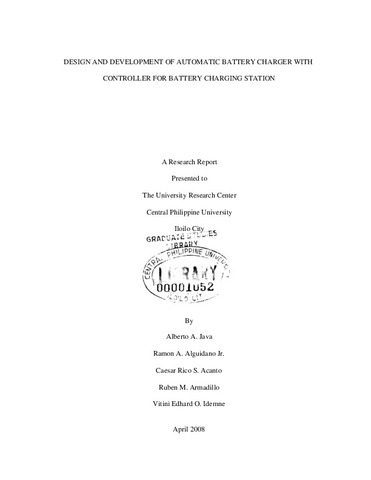| dc.contributor.author | Java, Alberto A. | |
| dc.contributor.author | Alguidano, Ramon A. Jr. | |
| dc.contributor.author | Acanto, Caesar Rico S. | |
| dc.contributor.author | Armadillo, Ruben M. | |
| dc.contributor.author | Idemne, Vitini Edhard O. | |
| dc.date.accessioned | 2021-05-20T06:41:32Z | |
| dc.date.available | 2021-05-20T06:41:32Z | |
| dc.date.issued | 2008-04 | |
| dc.identifier.citation | Java, A. A., Alguidano, R. A., Jr., Acanto, C. R. S., Armadillo, R. M., & Idemne, V. E. O. (2008). Design and development of automatic battery charger with controller for battery charging station (Research report). Jaro, Iloilo City: University Research Center, Central Philippine University. | en_US |
| dc.identifier.uri | https://hdl.handle.net/20.500.12852/890 | |
| dc.description | Abstract only | en_US |
| dc.description.abstract | The study aimed to design, develop, and constructs a locally-made battery charge controller for Battery Charging Station (BCS) project implemented by Central Philippine University-Affiliated Non-conventional Energy Center (CPU-ANEC). The charge controller is made up of thirteen blocks, Blocking diode, Shunt control element, trickle charge indicator, pulse width modulator (PWM), high voltage reconnect (HVR), high voltage disconnect (HVD), charge indicator, low voltage disconnect (LVD), low voltage reconnect (LVR), load controller, full charge indicator, and reverse polarity protection. The functionality of the charge controller was tested using solar panel, charge controller and the battery. The charging status and the battery state of charge was determined using the four light emitting diode (LED) indicator with four different colors, green LED for charging, Yellow LED for trickle charging, Orange LED for low battery voltage or LVD, and the red LED is for reverse polarity. The charging current are controlled by the PWM circuit, during charging the output of the PWM circuit was set to approximately ten percent (10%) duty cycle and approximately ninety percent (90%) duty cycle for trickle charging. To test PWM circuit, oscilloscope was used to display the output waveform of the PWM circuit and the checking of the duty cycle. Base on the result of testing, when the duty cycle is ten percent (10 %), the green LED light-up and ammeter reads maximum charging current, and if the duty cycle is ninety (90 %), yellow LED light-up, ammeters reads minimum current. The red LED will light-up only if the polarity of the battery is reverse, and the orange LED will light-up if the battery state of charge is empty. The testing of the charge controller was done for four days of continuous operation to ensure the reliability of the system. Base on the result of testing and evaluation, the charge controller worked as expected, working normally and the charge controller met the required parameters and is ready for use. | en_US |
| dc.format.extent | vi, 30 leaves: illustrations | en_US |
| dc.language.iso | en | en_US |
| dc.publisher | Central Philippine University | en_US |
| dc.rights | Attribution-NonCommercial-NoDerivs 3.0 Philippines | * |
| dc.rights.uri | http://creativecommons.org/licenses/by-nc-nd/3.0/ph/ | * |
| dc.subject.ddc | GSL 621.3072 J328 | en_US |
| dc.subject.lcsh | Battery chargers | en_US |
| dc.subject.lcsh | Battery chargers--Design and construction | en_US |
| dc.subject.lcsh | Electric current generators | en_US |
| dc.title | Design and development of automatic battery charger with controller for battery charging station | en_US |
| dc.type | Technical Report | en_US |
| dcterms.accessRights | Limited public access | en_US |
| dc.description.bibliographicalreferences | Includes bibliographical references | en_US |
| local.relation.associatedcontent | https://repository.cpu.edu.ph/handle/20.500.12852/56 Full paper published in Patubas | en_US |



